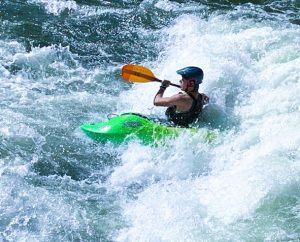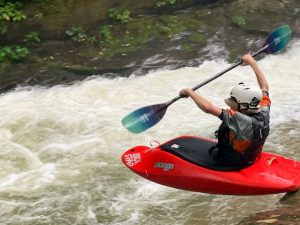The get-down command when paddling white water is very important because it will help you stay in control of raft’s direction. Paddling until the “stop” command is given can be tempting, especially in rapids with high-intensity currents. While paddling until the command is given, you should hold on to whatever you can to stay in the raft.
A good guide will teach you the get-down command, which means leaning over the raft’s high side. This command will help you balance your weight evenly and avoid a flip. When paddling white water, you should always follow instructions from the guide to ensure your safety.

Duffek stroke
If you are paddleboarding in white water, you need to know how to execute the Duffek stroke. It’s a compound stroke that will help you enter and exit an eddy, a section of turbulent water behind a large rock or other obstruction. It will also help you stay in position when running rapids.
The Duffek stroke requires a high degree of coordination. You must keep your knee straight while holding the paddle and keep your power face perpendicular to the current. In addition, the paddle blade must be turned with your movements. The Duffek can be executed with just one stroke, or you can use it as a powerful forward stroke.
Using eddy turns
One of the best techniques when paddling white water is using eddy turns. Eddy turns are a combination of position, angle, and edge and can feel effortless if done correctly. If you’re looking for more tips to improve your eddy turns, consider taking a whitewater class or purchasing Anna’s instructional DVD.
To use eddy turns correctly, paddle in the eddy’s direction of flow. This way, you can avoid drifting downstream in the main current. For example, if you’re paddling with a partner, you can aim lower into the eddy to make room for them.

Using torso rotation
Torso rotation is one of the most important parts of a kayaking stroke, so you’ll want to ensure that your torso is always moving when you’re paddling. It makes you more powerful when paddling, and it’s easier on your arms and shoulders.
To improve torso rotation, you must have a strong core and arms. By rotating your torso with every stroke, you’ll be able to strengthen your arms, shoulders, and core, making your strokes more powerful.
Common mistakes to avoid
A common mistake many beginners make is bracing their upper body when paddling. This makes them feel more stable but also limits their power. Instead, they should rotate their torso, which will improve their power and avoid causing injuries to their arms or shoulders. Taking the time to learn basic technique your will greatly improve your kayaking experience.
Paddling at the wrong angle can lead to a spinout or swaying kayak. The correct angle allows the paddle blade to have equal pressure on the water. By avoiding this mistake, you can paddle faster and more straight.